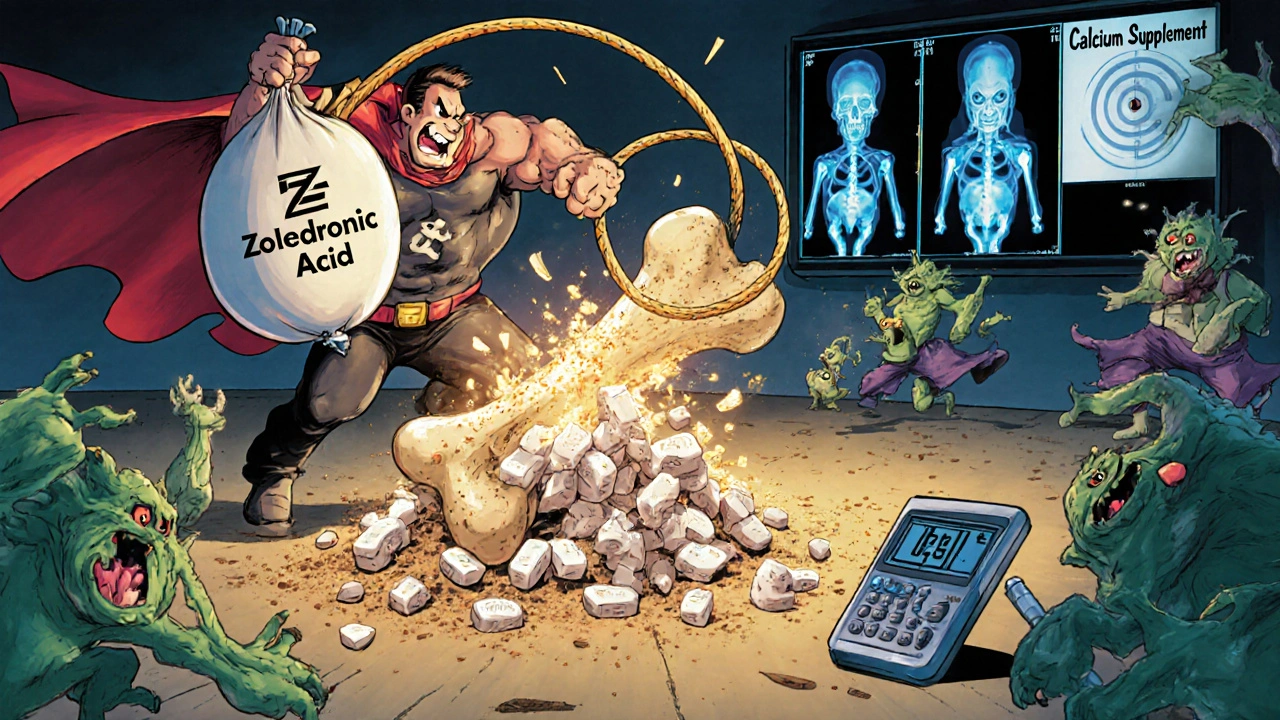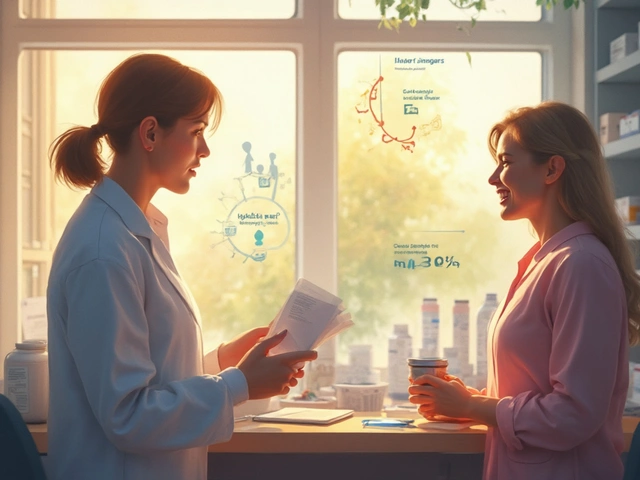Every year, over 2 million people in the U.S. break a bone because their bones have become too weak. Most of these fractures happen in people over 50, and many could have been avoided. The usual advice? Take calcium and vitamin D. But here’s the truth: calcium and vitamin D alone won’t stop most fractures - unless you’re deficient. And even then, they’re not the whole story.
Why Calcium and Vitamin D Don’t Work for Everyone
For years, doctors told everyone over 50 to take 1,000 mg of calcium and 800 IU of vitamin D daily to prevent fractures. It made sense - bones need calcium, and vitamin D helps your body absorb it. But when scientists looked at the actual data from large, well-run studies, the picture changed.
A 2019 review of 49,000 people found that when calcium and vitamin D were taken together, hip fractures dropped by 16%. That sounds good - until you realize that same study showed no benefit if you took less than 1,000 mg of calcium or less than 800 IU of vitamin D. Even worse, a separate analysis of over 36,000 postmenopausal women in the Women’s Health Initiative found that 1,000 mg of calcium and 400 IU of vitamin D did absolutely nothing to prevent fractures.
So why do some people still swear by their supplements? Because they’re not the same. If you’re living in a nursing home, haven’t seen sunlight in months, and eat mostly processed food, your vitamin D level might be below 12 ng/mL. In that case, adding 800 IU of vitamin D and 1,200 mg of calcium cut hip fractures by 43% - as shown in the landmark 1992 Chapuy study. But if you’re an active 65-year-old eating dairy, getting outside, and taking a multivitamin? Your levels are probably fine. Taking more won’t help. It might even hurt.
The US Preventive Services Task Force (USPSTF) now says: don’t take low-dose calcium and vitamin D if you’re healthy and living at home. The risks - like kidney stones and possible heart issues - outweigh the tiny or nonexistent benefits.
When Calcium and Vitamin D Actually Help
There are three groups where supplementation makes a real difference:
- You have a documented vitamin D deficiency (blood level under 20 ng/mL)
- You’re not getting enough calcium in your diet (less than 700 mg per day)
- You live in a care facility or rarely go outside
If you fit one or more of these, talk to your doctor about testing your 25-hydroxyvitamin D level. If it’s low, you might need a short course of high-dose vitamin D2 (50,000 IU once a week for 8-12 weeks), followed by a daily maintenance dose of 800-2,000 IU. Don’t just guess. Get tested.
For calcium, aim for 1,000-1,200 mg total per day - from food and supplements combined. Dairy, canned salmon with bones, fortified plant milks, and leafy greens like kale and bok choy are good sources. If you can’t get enough from food, use calcium carbonate or calcium citrate. Calcium carbonate needs stomach acid to absorb, so take it with meals. Calcium citrate works on an empty stomach and is better if you take acid-reducing meds.
And here’s a hard truth: calcium supplements increase your risk of kidney stones by 17%. If you’ve had one before, talk to your doctor before starting. Don’t take more than 1,200 mg daily from supplements unless you’re under medical supervision.

Bone-Building Medications: The Real Game Changers
If you’ve already broken a bone from a minor fall - or your bone density scan shows severe osteoporosis - supplements won’t cut it. You need medication that actually rebuilds or protects bone.
The most common are bisphosphonates: alendronate (Fosamax), risedronate (Actonel), and zoledronic acid (Reclast). These drugs slow down bone breakdown. In the Fracture Intervention Trial, alendronate reduced spine fractures by 44% and hip fractures by 51% over three years. Zoledronic acid, given as an annual IV infusion, cut hip fractures by 41% in just 18 months.
Then there are newer options:
- Denosumab (Prolia): A monthly injection that blocks a protein that breaks down bone. Reduces spine fractures by 68% and hip fractures by 40%.
- Teriparatide (Forteo) and Abaloparatide (Tymlos): These are anabolic agents - they actually build new bone. Used for severe cases. Teriparatide reduces spine fractures by up to 65%. Abaloparatide was approved in 2023 for men with osteoporosis, too.
- Romosozumab (Evenity): Works both ways - builds bone and slows breakdown. Shown to cut spine fractures by 73% in the first year.
These aren’t perfect. Bisphosphonates can rarely cause jawbone problems (osteonecrosis) or unusual thigh bone fractures after 5+ years of use. Denosumab requires strict adherence - if you miss a dose, bone loss can rebound fast. Teriparatide is limited to 2 years of use because of potential cancer risk in rats (though never seen in humans).
But here’s what matters: compared to supplements, these drugs reduce fracture risk by 40-70%. That’s not a small improvement. That’s life-changing.
Who Should Be on Medication?
Not everyone needs a prescription. The Fracture Risk Assessment Tool (FRAX®) helps doctors decide. It takes your age, sex, bone density, and other risk factors - like smoking, steroid use, or a previous fracture - and calculates your 10-year risk of a major fracture.
In the U.S., if your risk is over 20%, treatment is recommended. In the UK, it’s 15%. If you’ve already had a hip or spine fracture, you’re automatically in the high-risk group - no calculator needed.
Doctors also look at your bone density T-score. If it’s -2.5 or lower, you have osteoporosis. If it’s between -1.0 and -2.5, you have osteopenia. But even with osteopenia, if you’ve broken a bone, you still need medication.
And here’s something most people don’t know: many patients stop taking these drugs within a year. Why? Side effects. Oral bisphosphonates can cause heartburn, nausea, or esophageal irritation. About 68% of patients report GI issues. That’s why many switch to the yearly IV zoledronic acid - no daily pills, no stomach upset.

What You Can Do Right Now
If you’re over 50 and worried about breaking a bone:
- Get tested. Ask your doctor for a bone density scan (DEXA) and a vitamin D blood test. Don’t assume you’re deficient.
- Check your diet. Are you getting 1,000-1,200 mg of calcium a day? If not, fix that with food first.
- Move your body. Weight-bearing exercise - walking, lifting weights, tai chi - is one of the best ways to strengthen bones. Do it at least 30 minutes, 3-4 times a week.
- Stop smoking and limit alcohol. Smoking cuts bone density. More than two drinks a day increases fracture risk.
- Ask about medication. If you’ve had a fracture, or your FRAX score is high, don’t wait. Supplements won’t help enough.
Many people think bone health is just about popping pills. It’s not. It’s about knowing your numbers, understanding your real risk, and choosing the right tools - whether that’s a vitamin D shot, an annual infusion, or simply walking every morning.
What’s Coming Next
The osteoporosis treatment market is growing fast, with new drugs like abaloparatide now approved for men. Researchers are also testing whether high-dose vitamin D (2,000 IU/day) helps people with both low vitamin D and depression - a group at higher fracture risk. Results from that trial are expected by late 2025.
Meanwhile, experts are pushing for better follow-up. Too many patients start a drug and disappear. The best outcomes happen when treatment is monitored - with repeat DEXA scans every 1-2 years and regular check-ins to make sure side effects are managed.
The bottom line? Bone health isn’t about taking whatever’s on the shelf at the pharmacy. It’s about precision. Know your risk. Test your levels. Use the right tools. And don’t let outdated advice keep you from real protection.





Dana Dolan
November 20, 2025 AT 13:42Okay but like… I took calcium for years and still broke my wrist falling off a curb. My doctor just shrugged and said ‘well, maybe your vitamin D is low?’ I got tested-turned out I was fine. So yeah, supplements aren’t magic. I wish more people knew that.
Ellen Calnan
November 22, 2025 AT 13:14I used to think bone health was just about milk and sunshine-until my grandma fell and fractured her hip at 78. She wasn’t deficient in anything. Turns out, her body just stopped rebuilding bone like it used to. The real game-changer? Her annual Reclast infusion. No more daily pills. No more heartburn. Just a 15-minute IV once a year. She’s hiking again. I know it sounds like sci-fi, but medicine isn’t always about popping pills-it’s about knowing what your bones actually need.
Richard Risemberg
November 24, 2025 AT 03:53Let me tell you something-bones aren’t just calcium statues. They’re alive, dynamic, screaming for movement. I used to be the guy who thought ‘I’ll just take my vitamins and be fine.’ Then I started lifting weights at 62. Not bodybuilding, just dumbbells and squats. My DEXA scan went from -2.8 to -1.9 in 18 months. No drugs. Just gravity and consistency. Vitamin D? Fine. Calcium? Got it from yogurt and kale. But movement? That’s the secret sauce. Your bones don’t care about your supplement shelf-they care about your boots hitting the pavement.
Marjorie Antoniou
November 25, 2025 AT 18:14I’m a nurse. I’ve seen patients stop bisphosphonates because of stomach issues… then end up in the ER with a hip fracture six months later. It’s heartbreaking. The real tragedy isn’t the side effects-it’s that people think supplements are enough. If you’ve had a fracture, you’re not ‘just getting old.’ You’re at high risk. And if your doctor isn’t talking to you about Prolia or Evenity, find a new one. Your bones deserve better than placebo-level advice.
Frank Dahlmeyer
November 26, 2025 AT 02:04Look, I get it-people want quick fixes. Take a pill, feel better. But bone health? It’s a marathon with a thousand tiny steps. You need the DEXA scan, you need the vitamin D test, you need to walk every day, you need to eat your greens, you need to stop smoking, you need to talk to your doctor about medication if you’re high risk, you need to track your progress, you need to not give up when the first pill gives you heartburn, you need to understand that your bones aren’t going to magically heal just because you bought a bottle of calcium from Walmart, you need to realize that your body is not a vending machine, you need to accept that aging doesn’t mean surrendering to fragility, you need to be proactive, not passive, you need to stop listening to influencers who say ‘just take more calcium’ and start listening to science, you need to stop treating your skeleton like an afterthought, and you need to remember that your future self will thank you if you start today-not when you’re in a wheelchair.
Codie Wagers
November 26, 2025 AT 23:38Let’s be honest: the entire osteoporosis industry is built on fear and placebo pills. Doctors push supplements because they’re easy. Pharma pushes drugs because they’re profitable. Meanwhile, the real solution-nutrition, sunlight, movement-is free and ignored. And don’t even get me started on ‘bone-building’ meds. Teriparatide? That’s a lab-made parathyroid hormone. You’re injecting a hormone your body makes naturally… and you’re paying $10,000 a year for it. The system is rigged. Stop trusting the algorithm. Start trusting your body.
Paige Lund
November 27, 2025 AT 06:21So… I take calcium. I get sunlight. I walk my dog. And I still have osteopenia. Guess what? I’m not surprised. I’m 67. My bones are old. Maybe I’ll just let them break and see what happens. At least then I’ll get a free MRI.
Reema Al-Zaheri
November 28, 2025 AT 05:04Regarding calcium absorption: calcium carbonate requires stomach acid, so it must be taken with meals; calcium citrate does not require stomach acid and is preferable for those taking proton-pump inhibitors or H2 blockers. Furthermore, splitting daily calcium intake into doses of 500 mg or less improves absorption. Many patients consume 1,200 mg in a single dose, which is physiologically inefficient. Also, magnesium and vitamin K2 are critical cofactors often overlooked in bone health protocols.
Michael Salmon
November 28, 2025 AT 10:50Oh wow, another ‘trust your doctor’ article. Let me guess-your doctor gets kickbacks from pharma reps? The ‘annual IV’ is just a fancy way to keep you hooked on expensive treatments. Meanwhile, real bone density improves with resistance training, protein intake, and vitamin K2-not some $15,000/year drug that might give you jaw necrosis. You’re selling fear, not science. And don’t even mention ‘FRAX.’ That algorithm was built by people who’ve never held a dumbbell. Real people move. Real people eat real food. Real people don’t need your pills.